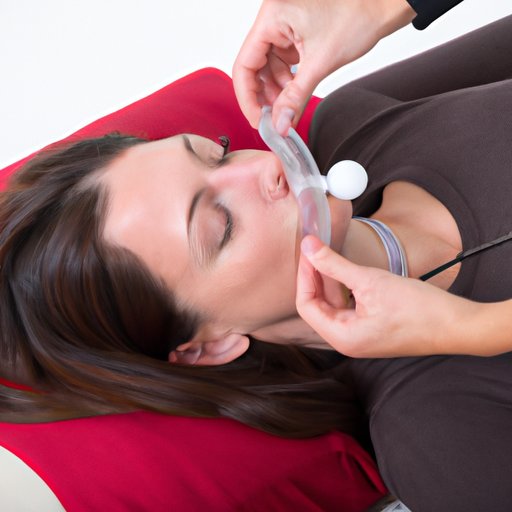
Introduction
The vagus nerve is the longest nerve in the body, running from the base of the brain down through the chest and stomach. It plays a crucial role in regulating various bodily functions, including digestion, inflammation, and cardiovascular health. In this article, we will explore simple breathing exercises that can stimulate the vagus nerve and improve overall well-being.
The Science Behind Vagus Nerve Stimulation
The vagus nerve is a complex system that consists of both sensory and motor neurons. The sensory neurons are responsible for conveying information from the body’s organs to the brain, while the motor neurons control the organs’ functions by regulating the heart rate and digestive processes. Various stimuli can activate the vagus nerve, including exercise, meditation, and deep breathing techniques.
Benefits of Vagus Nerve Stimulation
Vagus nerve stimulation has numerous potential benefits for overall health and well-being. Studies have shown that stimulating the vagus nerve through breathing exercises can improve digestion, reduce inflammation, and promote better cardiovascular health.
Improved digestion
The vagus nerve plays a significant role in the digestive system by regulating the stomach’s acid production and controlling the digestive muscles’ contractions. By stimulating the vagus nerve through breathing exercises, you can improve digestion and effectively regulate digestive functions.
Reduced inflammation
The vagus nerve has anti-inflammatory properties, which makes it essential in fighting inflammation in different parts of the body. Stimulating it through breathing enhances its ability to reduce inflammation, reducing the chances of developing diseases.
Better cardiovascular health
The vagus nerve is a significant contributor to your heart health. It controls your heart rate and helps maintain a healthy blood pressure level. Stimulating the vagus nerve through breathing techniques can improve the heart’s overall health and significantly reduce the risk of heart disease.
5 Simple Breathing Exercises for Vagus Nerve Stimulation
Now that we know the benefits of stimulating the vagus nerve, here are five simple exercises that you should try:
4-7-8 breathing technique
The 4-7-8 breathing technique is a powerful breathing exercise for calming the mind and stimulating the vagus nerve. It involves breathing in for 4 seconds, holding your breath for 7 seconds, and exhaling for 8 seconds. Repeat the cycle for 5-10 minutes.
Alternate nostril breathing
This technique is an excellent exercise for balancing the right and left sides of the brain and stimulating the vagus nerve. Close your left nostril with one finger and inhale deeply through the right nostril. Close your right nostril with your thumb, hold your breath for a few seconds, then release your left nostril and exhale through it. Repeat the cycle for 5-10 minutes.
Slow abdominal breathing
Slow abdominal breathing is an easy and effective technique for stimulating the vagus nerve. Sit in a comfortable position, place your hand over your stomach, inhale slowly through your nose, and feel your stomach expand. Exhale slowly through your mouth, feeling your stomach contract. Repeat the cycle for 5-10 minutes.
Humming
Humming is a simple technique that can enhance vagus nerve stimulation. Close your eyes, take a deep breath, and hum as you exhale. Focus on the vibrations in your throat as you hum. Repeat the cycle for 5-10 minutes.
Pathakumbhaka (breath retention)
This technique involves holding your breath for a few seconds and is effective in stimulating the vagus nerve and improving overall health. Inhale deeply through your nose, hold your breath for a few seconds, and slowly exhale through your mouth. Repeat the cycle for 5-10 minutes.
How to Incorporate Vagus Nerve-Stimulating Breathing Exercises into Your Daily Routine
Practicing the above exercises regularly can significantly improve overall well-being. Here are a few tips on incorporating these exercises in your daily routine:
Set aside time every day
Allocate a specific time each day to practice these exercises. A few minutes in the morning or evening can make a significant difference in your overall health.
Practice these exercises during breaks
Whenever you feel stressed or need to clear your mind, take a 5-10 minute break and practice these exercises. You will notice a significant difference in your mood and overall well-being.
Practice these exercises before bed
Practicing vagus nerve-stimulating techniques before bed can improve the quality of your sleep, leading to better health and well-being.
Conclusion
Vagus nerve stimulation is an easy and effective way to improve overall health and well-being. By practicing simple breathing exercises, such as the 4-7-8 technique, alternate nostril breathing, slow abdominal breathing, humming, and Pathakumbhaka, you can stimulate the vagus nerve, leading to improved digestion, reduced inflammation, and better cardiovascular health. Try to incorporate these exercises into your daily routine for better overall health and well-being.




